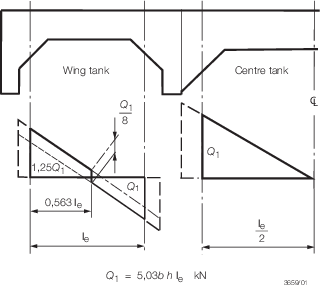4.4.2 The
section modulus of vertical webs on transverse bulkheads and of horizontal
girders is to be not less than:
4.4.3 The
net sectional area of the web at any section is to be not less than:
where Q
x is the shear force
at the section. For the horizontal girders on ships with two longitudinal
bulkheads, Q
x is calculated from shear force
diagrams as shown in Figure 10.4.1 Horizontal girders.
For end connections, Q
x is to be determined
by projection of the shear force diagrams as indicated.
4.4.4 The
moment of inertia of vertical webs and horizontal girders is to be
not less than:
4.4.5 For
the calculation of section modulus, the minimum span of horizontal
girders on longitudinal bulkheads is to be taken as not less than
the lesser of (1,2 + 0,02L) m or 3 m.

Figure 10.4.1 Horizontal girders